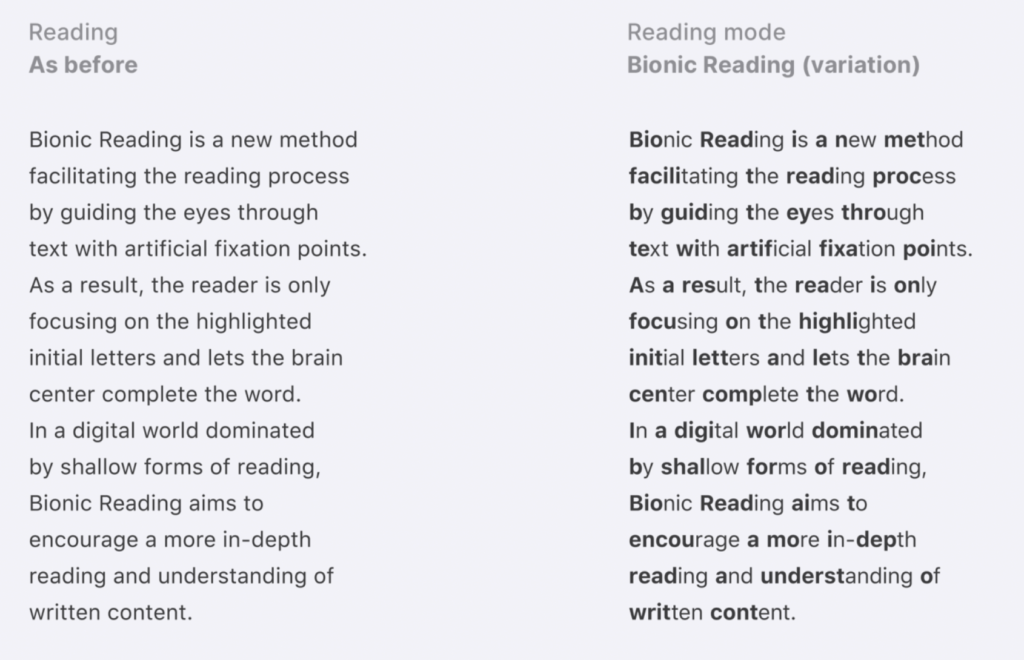Can adjusting font styles really help us read faster?
Its creator is undeterred by skeptics. To him, likes and shares on social media is enough. …

What if there was a fast and simple way for us to learn to how to read more efficiently?
That’s what Bionic Reading claims to do. The methodology, first developed in 2016, seeks to help distracted adults improve how they parse information by bolding a few letters within a block of text. This typographic trick purportedly shortens the time needed for our brains to process data.
The technique has already gotten a lot of buzz on social media. With the promise of faster, better, deeper, distraction-free reading, Bionic Reading has also received considerable attention from the press. Its most prominent endorsement so far is a spotlight on the World Economic Forum’s website.
But for some, Bionic Reading’s pitch sounds too good to be true. Now several type design experts and researchers are questioning its efficacy.
The claim
Processing a few highlighted characters (which its creator, Swiss entrepreneur Renato Casutt, calls “fixation points”) helps us read faster because we don’t have to process full words. Our brains, in theory, complete words and sentences before our eyes can finish reading them.
Though Bionic Reading’s pitch to overburdened readers is laden with references to neuroscience, the reading method has yet to undergo rigorous scientific evaluation.
Casutt launched his big idea after testing it with only a small group of 12 readers, and even then the findings were inconclusive. “The results are not clear,” he reveals on his website, describing a study funded by the Swiss accelerator Innosuisse. “But it can be said that the majority had a positive effect. Of course there were also probands [subjects] who found the effect disturbing”—likely bothered by the irregularities in graphic display.

Bionic Reading
Bionic Reading, which is available as an API and as a Google Chrome extension, is particularly compelling for people with dyslexia, Casutt asserts, though he reveals that it hasn’t been explicitly tested within this population of readers. Casutt says that he is shaping Bionic Reading based largely on anecdotal evidence from the neurodivergent community, referring to users with dyslexia or attention-deficit/hyperactivity disorder, on social media.
Kicking the tires
Meanwhile, founders of the content organization app Readwise recently conducted an informal, non-peer reviewed pilot study after being bombarded by requests to integrate Bionic Reading on the platform. “This isn’t just some one-off request. I’ve received more tweets, DMs, emails, Discord messages, and survey responses in our history requesting—nay, fiending—that we implement Bionic Reading in our new reading application,” Daniel Doyon, Readwise co-founder, writes in a June 21 blog.
As a hackathon project, Doyon and software developer Mati Tucci created a quick experiment to determine whether Bionic Reading’s method helped people read faster or better. The experiment, however, only showed minimal gains—the 61 participants who took the 20-minute reading test only registered a marginal 4% improvement in reading speeds, and a decrease in comprehension. “There’s not enough evidence to claim that the average reading speed of Bionic Reading is significantly different from the average reading speed of [text displayed in the regular version of the font] Garamond,” Doyon reports.
Readwise is currently conducting another public experiment to further improve its insights about Bionic Reading, which will affect whether it incorporates Bionic Reading into its platform.
Casutt is undeterred by skeptics. To him, attention on social media is enough. “Bionic Reading has gone viral—over 7 million views on TikTok [on] just one post; [It has been] liked and shared millions of times on Twitter,” he explains to Quartz in an email. “I don’t think Bionic Reading would have gone viral if it didn’t make a positive impact for readers. Millions of people, including me, think Bionic Reading works.”
More testing, he says, is coming—though it’s not a priority. “Of course we will develop a study explicitly on Bionic Reading within the ADHD community, but not today and not tomorrow,” Casutt adds. “Studies on how we humans read exist in very, very large number[s].”
Debunking miracle fonts
This isn’t the first time a font has made big promises that some have doubted it could live up to.
In his blog Type Guru, German type designer Ralf Herrmann suggests that Bionic Reading might mirror Sans Forgetica, a typeface that went viral in 2018 for promising to improve our memory by making text intentionally hard to read. Conceived by a team of designers and behavioral scientists at the Royal Melbourne Institute of Technology University, its efficacy has since been disproven by a study conducted by researchers at the University of Warwick and the University of Waikato, New Zealand in 2020. Their findings, published in the journal Memory, suggest that Sans Forgetica performed no better than plain old Arial when it comes to information retention.

RMIT University
Mevagh Sanson, a research fellow at University of Waikato and one of the authors of the Sans Forgetica study, says that a series of experiments is necessary to substantiate Bionic Reading’s claims.
“Until there are peer-reviewed, empirical demonstrations of Bionic Reading’s effectiveness published, we would advise that people are better off relying on interventions that have a solid scientific grounding to improve their ability to remember what they read,” she explains in an email to Quartz. “[This includes} reading aloud, or spacing out when they re-read information.”
Sanson adds that the attitude a reader has towards Bionic Reading, say after reading about glowing testimonials on social media, may also have bearing on its efficacy. “If people expect the ‘bionic passages’ to help them, they may try harder, for instance, and feel better about their reading performance—essentially creating a self-fulfilling prophecy about positive effects of Bionic Reading that actually has little to do with the passage’s visual properties.”
“Generally, there is a cognitive trade-off between processing information more quickly and processing information more deeply or thoroughly,” explains Sanson. “You really can’t improve both at once.”